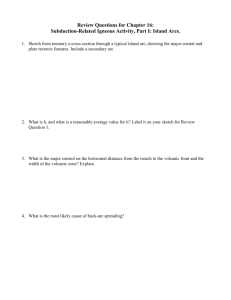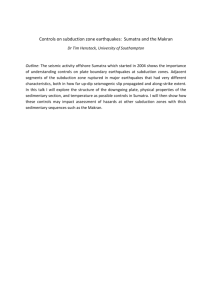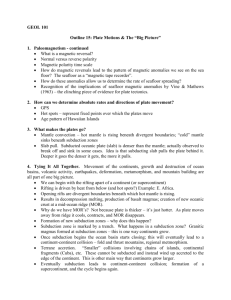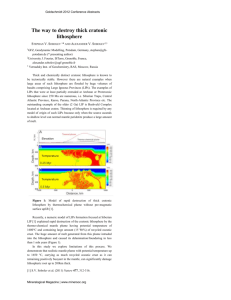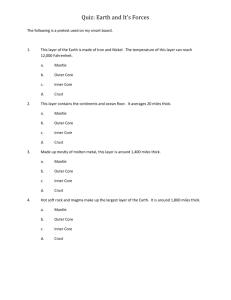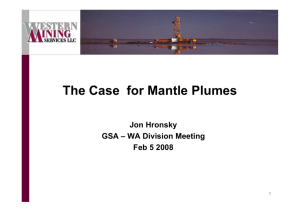Ueda_Kosuke_Poster - SWISS GEOSCIENCE MEETINGs
advertisement
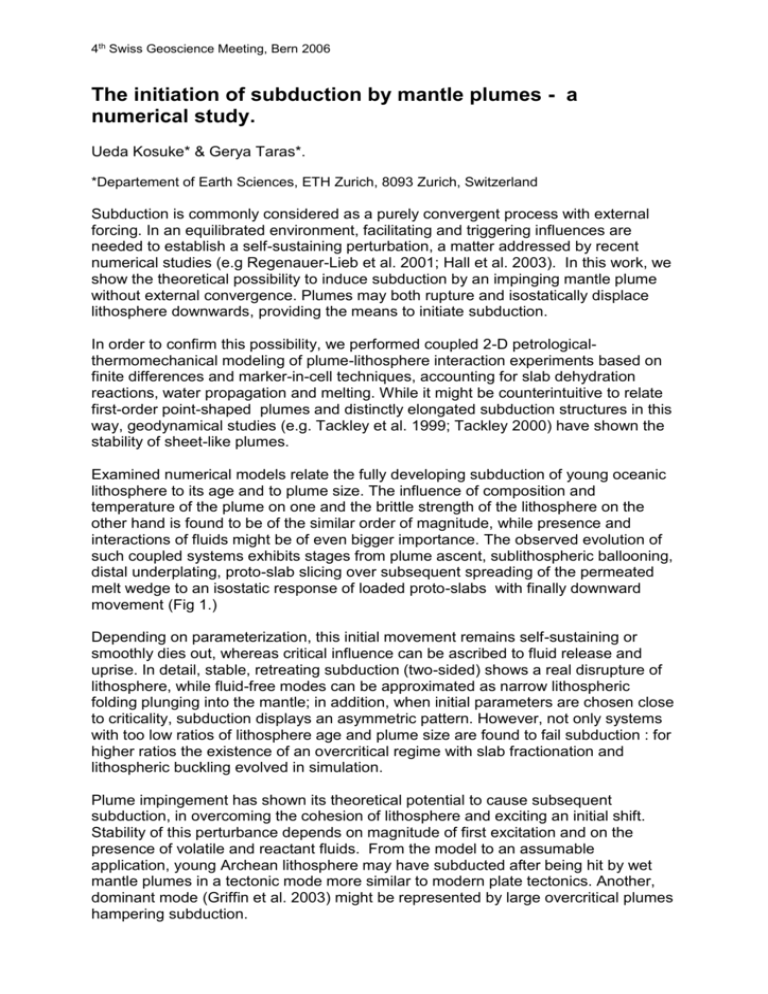
4th Swiss Geoscience Meeting, Bern 2006 The initiation of subduction by mantle plumes - a numerical study. Ueda Kosuke* & Gerya Taras*. *Departement of Earth Sciences, ETH Zurich, 8093 Zurich, Switzerland Subduction is commonly considered as a purely convergent process with external forcing. In an equilibrated environment, facilitating and triggering influences are needed to establish a self-sustaining perturbation, a matter addressed by recent numerical studies (e.g Regenauer-Lieb et al. 2001; Hall et al. 2003). In this work, we show the theoretical possibility to induce subduction by an impinging mantle plume without external convergence. Plumes may both rupture and isostatically displace lithosphere downwards, providing the means to initiate subduction. In order to confirm this possibility, we performed coupled 2-D petrologicalthermomechanical modeling of plume-lithosphere interaction experiments based on finite differences and marker-in-cell techniques, accounting for slab dehydration reactions, water propagation and melting. While it might be counterintuitive to relate first-order point-shaped plumes and distinctly elongated subduction structures in this way, geodynamical studies (e.g. Tackley et al. 1999; Tackley 2000) have shown the stability of sheet-like plumes. Examined numerical models relate the fully developing subduction of young oceanic lithosphere to its age and to plume size. The influence of composition and temperature of the plume on one and the brittle strength of the lithosphere on the other hand is found to be of the similar order of magnitude, while presence and interactions of fluids might be of even bigger importance. The observed evolution of such coupled systems exhibits stages from plume ascent, sublithospheric ballooning, distal underplating, proto-slab slicing over subsequent spreading of the permeated melt wedge to an isostatic response of loaded proto-slabs with finally downward movement (Fig 1.) Depending on parameterization, this initial movement remains self-sustaining or smoothly dies out, whereas critical influence can be ascribed to fluid release and uprise. In detail, stable, retreating subduction (two-sided) shows a real disrupture of lithosphere, while fluid-free modes can be approximated as narrow lithospheric folding plunging into the mantle; in addition, when initial parameters are chosen close to criticality, subduction displays an asymmetric pattern. However, not only systems with too low ratios of lithosphere age and plume size are found to fail subduction : for higher ratios the existence of an overcritical regime with slab fractionation and lithospheric buckling evolved in simulation. Plume impingement has shown its theoretical potential to cause subsequent subduction, in overcoming the cohesion of lithosphere and exciting an initial shift. Stability of this perturbance depends on magnitude of first excitation and on the presence of volatile and reactant fluids. From the model to an assumable application, young Archean lithosphere may have subducted after being hit by wet mantle plumes in a tectonic mode more similar to modern plate tectonics. Another, dominant mode (Griffin et al. 2003) might be represented by large overcritical plumes hampering subduction. 4th Swiss Geoscience Meeting, Bern 2006 Figure 1. Development stages of subduction following plume impingement. Stable cases: After ballooning beneath the lithosphere, a wedge of plume material rises up (a), cuts the proto-slabs, spreads over them and displaces them downwards (b). Critical cases: subduction develops asymmetrically and may stop after neck-off (c). Overcriticality: plume material “burns through”, fragmenting or resorbing lithosphere (d). Plumes (a) - (c) of hydrated mantle, (d) of felsic composition. REFERENCES Griffin, W., O’Reilly, S., Abe, N., Aulbach, S., Davies, R., Pearson, N., Doyle, B. & Kivi, K. (2003): The origin and evolution of Archean lithospheric mantle. Precambrian Research 127 : 19-42. Hall, C.E., Gurnis, M., Sdrolias, M., Lavier, L. & Müller, R. (2003): Catastrophic initiation of subduction following forced convergence across fracture zones. Earth and Planetary Science Letters 212 : 15-30. Regenauer-Lieb, K., Yuen, D.A. & Branlund, J. (2001): The Initiation of Subduction: Criticality by Addition of Water? Science 294. Tackley, P.J., Baumgardner, J.R., Glatzmaier, G.A., Olson, P., & Clune, T. (1999): Three-dimensional spherical simulations of convection in Earth's mantle and core using massively-parallel computers. In Proceedings of HPC99, ed. Tentner A. : 95100. Tackley, P.J. (2000): Self-consistent generation of tectonic plates in time-dependent, three-dimensional mantle convection simulations. Geochemistry, Geophysics, Geosystems 1.
